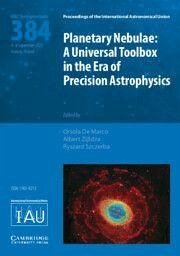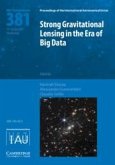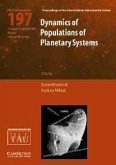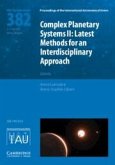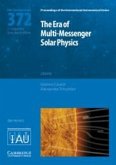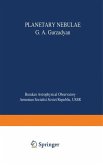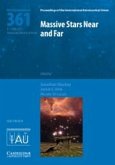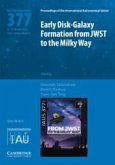Planetary Nebulae (Iau S384)
A Universal Toolbox in the Era of Precision Astrophysics
Herausgeber: de Marco, Orsola; Szczerba, Ryszard; Zijlstra, Albert
Planetary Nebulae (Iau S384)
A Universal Toolbox in the Era of Precision Astrophysics
Herausgeber: de Marco, Orsola; Szczerba, Ryszard; Zijlstra, Albert
- Gebundenes Buch
- Merkliste
- Auf die Merkliste
- Bewerten Bewerten
- Teilen
- Produkt teilen
- Produkterinnerung
- Produkterinnerung
Planetary nebulae are generated when the outer layers of intermediate-mass stars are ejected during the second giant expansion after core helium burning has ceased. The star, ultimately destined to becoming a white dwarf, ionises the ejecta revealing intricate nebular shapes. Over the years, the initial awe inspired by these beautiful displays has turned into the realisation of the vast number of astrophysical questions that can be tackled using planetary nebulae. This volume collects a series of contributions to IAU Symposium 384, which show the breadth of problems that can be addressed with…mehr
Andere Kunden interessierten sich auch für
![Strong Gravitational Lensing in the Era of Big Data (Iau S381) Strong Gravitational Lensing in the Era of Big Data (Iau S381)]() Strong Gravitational Lensing in the Era of Big Data (Iau S381)138,99 €
Strong Gravitational Lensing in the Era of Big Data (Iau S381)138,99 €![Dynamics of Populations of Planetary Systems (Iau C197) Dynamics of Populations of Planetary Systems (Iau C197)]() Zoran Knezevic (ed.)Dynamics of Populations of Planetary Systems (Iau C197)81,99 €
Zoran Knezevic (ed.)Dynamics of Populations of Planetary Systems (Iau C197)81,99 €![Complex Planetary Systems II (Iau S382) Complex Planetary Systems II (Iau S382)]() Complex Planetary Systems II (Iau S382)138,99 €
Complex Planetary Systems II (Iau S382)138,99 €![The Era of Multi-Messenger Solar Physics (Iau S372) The Era of Multi-Messenger Solar Physics (Iau S372)]() The Era of Multi-Messenger Solar Physics (Iau S372)138,99 €
The Era of Multi-Messenger Solar Physics (Iau S372)138,99 €![Planetary Nebulae Planetary Nebulae]() Grigor A. GurzadyanPlanetary Nebulae39,99 €
Grigor A. GurzadyanPlanetary Nebulae39,99 €![Massive Stars Near and Far (Iau S361) Massive Stars Near and Far (Iau S361)]() Massive Stars Near and Far (Iau S361)138,99 €
Massive Stars Near and Far (Iau S361)138,99 €![Early Disk-Galaxy Formation from Jwst to the Milky Way (Iau S377) Early Disk-Galaxy Formation from Jwst to the Milky Way (Iau S377)]() Early Disk-Galaxy Formation from Jwst to the Milky Way (Iau S377)129,99 €
Early Disk-Galaxy Formation from Jwst to the Milky Way (Iau S377)129,99 €-
-
-
Planetary nebulae are generated when the outer layers of intermediate-mass stars are ejected during the second giant expansion after core helium burning has ceased. The star, ultimately destined to becoming a white dwarf, ionises the ejecta revealing intricate nebular shapes. Over the years, the initial awe inspired by these beautiful displays has turned into the realisation of the vast number of astrophysical questions that can be tackled using planetary nebulae. This volume collects a series of contributions to IAU Symposium 384, which show the breadth of problems that can be addressed with these objects: from the dynamical and chemical evolutions of galaxies and clusters, to the evolution of stars, to binary interactions, and to the exploration of the chemistry of life. Researchers from many astronomical fields can discover how observational tools from planetary nebulae can be applied to inform and benefit their own work.
Produktdetails
- Produktdetails
- Verlag: Cambridge University Press
- Seitenzahl: 400
- Erscheinungstermin: 31. Oktober 2025
- Englisch
- ISBN-13: 9781009399326
- ISBN-10: 1009399322
- Artikelnr.: 74201353
- Herstellerkennzeichnung
- Libri GmbH
- Europaallee 1
- 36244 Bad Hersfeld
- gpsr@libri.de
- Verlag: Cambridge University Press
- Seitenzahl: 400
- Erscheinungstermin: 31. Oktober 2025
- Englisch
- ISBN-13: 9781009399326
- ISBN-10: 1009399322
- Artikelnr.: 74201353
- Herstellerkennzeichnung
- Libri GmbH
- Europaallee 1
- 36244 Bad Hersfeld
- gpsr@libri.de
Session I. Focus on PN as populations and as tools (extragalactic PN):
Planetary nebulae as probes of kinematics and abundances to trace galaxy
evolution Letizia Stanghellini; Astronomical outreach and education in
marginalised and indigenous communities: astronomy as a tool for social
development Arianna Cortesi; Planetary nebulae as tracers of stellar
population properties Ana Ennis; Survey of llanetary nebulae in the
Andromeda galaxy (M31) Souradeep Bhattacharya; Analysis of distances to
planetary nebulae Diego Hernández-Juárez; GTC spectroscopic surveys of
planetary nebulae in the Milky Way and M31 Xuan Fang; Probing the local
planetary nebula luminosity function with Gaia Nicholas Chornay; Integral
field spectroscopy: a disruptive innovation for observations of Planetary
Nebulae and the PNLF Martin Roth; Precision spectrophotometry for PNLF
distances: the case of NGC 300 Azlizan Adhyaqsa Soemitro; PICS: Planetary
nebulae in cosmological simulations Lucas Valenzuela; Towards precision
cosmology with improved PNLF distances using VLT-MUSE George Jacoby; Using
adaptive-optics assisted MUSE observations to measure galaxy distances with
the Planetary Nebulae luminosity function Saskia Schlagenhauf; Kinematics
of the diffuse intragroup/intracluster light in groups and clusters of
galaxies in the Local Universe (within 100 Mpc) Magda Arnaboldi; A new
population of stars between the LMC and the MW revealed by post-AGB stars
Minia Manteiga Outeiro; Diverse science from VLT imagery and spectroscopy
of PNe in the Galactic Bulge Quentin Parker; Planetary nebulae populations
in the haloes of nearby massive early-type galaxies Johanna Hartke; Session
II. Focus on PN abundances/chemistry/dust: On determining the chemical
composition of planetary nebulae Grazyna Stasinska; The structure of
emission lines in planetary nebulae at very high spectral resolution
Michael Richer; Precise determination of extinction correction and plasma
diagnostics Toshiya Ueta; Abundance determination in PNe: How to deal with
large chemical inhomogeneities Christophe Morisset; A statistical view of
low-ionization structures in planetary nebulae M. Mari; What do we really
know about the low-ionization structures in planetary nebulae? Stavros
Akras; Probing the physical and chemical properties of planetary nebulae
using precision photoionization modelling Hektor Monteiro; JWST imaging
observations of the Ring Nebula Roger Wesson; Remarkable chemical
complexity in planetary nebulae: A molecule and dust perspective Lucy
Ziurys; ALMA observations of molecular line emission from high-excitation
bipolar planetary nebulae Paula Moraga Baez; Morpho-kinematical modelling
in the molecular zoo beyond CO: the case of M 1-92 Miguel Santander-García;
Session III. Focus on PN chemistry/dust: Dust production from low- and
intermediate-mass stars: new insights from post-AGB stars and PNe Flavia
Dell'Agli; Deep radio observations of (proto-) planetary nebulae Teresa
Huertas-Roldán; Synthesis of complex organics in planetary nebulae Sun
Kwok; NanoSpace: Networking to understand carbon molecular nanostructures
in PNe Domingo García-Hernández; Dust formation in AGB stars and planetary
nebulae Mikako Matsuura; The Red Rectangle: a thin disk with big grains
Javier Alcolea; Dust formation during the interaction of binary stars by
common envelope Luis Carlos Bermúdez Bustamante; Session IV. Focus on
stellar evolution; evolutionary scenarios; including binaries: The
evolutionary path from the AGB to the PN phases: certainties and open
issues Paolo Ventura; Nova remnants ... the fast siblings of planetary
nebulae Martin Guerrero; Evolution from Asymptotic Giant Branch to
Pre-planetary Nebula: Whorled patterns and stellar companions Hyosun Kim;
NGC 1514 and the post-AGB mass-luminosity relation Roberto Mendez;
Monitoring of dynamical processes in outer atmospheres of cool protopla
Planetary nebulae as probes of kinematics and abundances to trace galaxy
evolution Letizia Stanghellini; Astronomical outreach and education in
marginalised and indigenous communities: astronomy as a tool for social
development Arianna Cortesi; Planetary nebulae as tracers of stellar
population properties Ana Ennis; Survey of llanetary nebulae in the
Andromeda galaxy (M31) Souradeep Bhattacharya; Analysis of distances to
planetary nebulae Diego Hernández-Juárez; GTC spectroscopic surveys of
planetary nebulae in the Milky Way and M31 Xuan Fang; Probing the local
planetary nebula luminosity function with Gaia Nicholas Chornay; Integral
field spectroscopy: a disruptive innovation for observations of Planetary
Nebulae and the PNLF Martin Roth; Precision spectrophotometry for PNLF
distances: the case of NGC 300 Azlizan Adhyaqsa Soemitro; PICS: Planetary
nebulae in cosmological simulations Lucas Valenzuela; Towards precision
cosmology with improved PNLF distances using VLT-MUSE George Jacoby; Using
adaptive-optics assisted MUSE observations to measure galaxy distances with
the Planetary Nebulae luminosity function Saskia Schlagenhauf; Kinematics
of the diffuse intragroup/intracluster light in groups and clusters of
galaxies in the Local Universe (within 100 Mpc) Magda Arnaboldi; A new
population of stars between the LMC and the MW revealed by post-AGB stars
Minia Manteiga Outeiro; Diverse science from VLT imagery and spectroscopy
of PNe in the Galactic Bulge Quentin Parker; Planetary nebulae populations
in the haloes of nearby massive early-type galaxies Johanna Hartke; Session
II. Focus on PN abundances/chemistry/dust: On determining the chemical
composition of planetary nebulae Grazyna Stasinska; The structure of
emission lines in planetary nebulae at very high spectral resolution
Michael Richer; Precise determination of extinction correction and plasma
diagnostics Toshiya Ueta; Abundance determination in PNe: How to deal with
large chemical inhomogeneities Christophe Morisset; A statistical view of
low-ionization structures in planetary nebulae M. Mari; What do we really
know about the low-ionization structures in planetary nebulae? Stavros
Akras; Probing the physical and chemical properties of planetary nebulae
using precision photoionization modelling Hektor Monteiro; JWST imaging
observations of the Ring Nebula Roger Wesson; Remarkable chemical
complexity in planetary nebulae: A molecule and dust perspective Lucy
Ziurys; ALMA observations of molecular line emission from high-excitation
bipolar planetary nebulae Paula Moraga Baez; Morpho-kinematical modelling
in the molecular zoo beyond CO: the case of M 1-92 Miguel Santander-García;
Session III. Focus on PN chemistry/dust: Dust production from low- and
intermediate-mass stars: new insights from post-AGB stars and PNe Flavia
Dell'Agli; Deep radio observations of (proto-) planetary nebulae Teresa
Huertas-Roldán; Synthesis of complex organics in planetary nebulae Sun
Kwok; NanoSpace: Networking to understand carbon molecular nanostructures
in PNe Domingo García-Hernández; Dust formation in AGB stars and planetary
nebulae Mikako Matsuura; The Red Rectangle: a thin disk with big grains
Javier Alcolea; Dust formation during the interaction of binary stars by
common envelope Luis Carlos Bermúdez Bustamante; Session IV. Focus on
stellar evolution; evolutionary scenarios; including binaries: The
evolutionary path from the AGB to the PN phases: certainties and open
issues Paolo Ventura; Nova remnants ... the fast siblings of planetary
nebulae Martin Guerrero; Evolution from Asymptotic Giant Branch to
Pre-planetary Nebula: Whorled patterns and stellar companions Hyosun Kim;
NGC 1514 and the post-AGB mass-luminosity relation Roberto Mendez;
Monitoring of dynamical processes in outer atmospheres of cool protopla
Session I. Focus on PN as populations and as tools (extragalactic PN):
Planetary nebulae as probes of kinematics and abundances to trace galaxy
evolution Letizia Stanghellini; Astronomical outreach and education in
marginalised and indigenous communities: astronomy as a tool for social
development Arianna Cortesi; Planetary nebulae as tracers of stellar
population properties Ana Ennis; Survey of llanetary nebulae in the
Andromeda galaxy (M31) Souradeep Bhattacharya; Analysis of distances to
planetary nebulae Diego Hernández-Juárez; GTC spectroscopic surveys of
planetary nebulae in the Milky Way and M31 Xuan Fang; Probing the local
planetary nebula luminosity function with Gaia Nicholas Chornay; Integral
field spectroscopy: a disruptive innovation for observations of Planetary
Nebulae and the PNLF Martin Roth; Precision spectrophotometry for PNLF
distances: the case of NGC 300 Azlizan Adhyaqsa Soemitro; PICS: Planetary
nebulae in cosmological simulations Lucas Valenzuela; Towards precision
cosmology with improved PNLF distances using VLT-MUSE George Jacoby; Using
adaptive-optics assisted MUSE observations to measure galaxy distances with
the Planetary Nebulae luminosity function Saskia Schlagenhauf; Kinematics
of the diffuse intragroup/intracluster light in groups and clusters of
galaxies in the Local Universe (within 100 Mpc) Magda Arnaboldi; A new
population of stars between the LMC and the MW revealed by post-AGB stars
Minia Manteiga Outeiro; Diverse science from VLT imagery and spectroscopy
of PNe in the Galactic Bulge Quentin Parker; Planetary nebulae populations
in the haloes of nearby massive early-type galaxies Johanna Hartke; Session
II. Focus on PN abundances/chemistry/dust: On determining the chemical
composition of planetary nebulae Grazyna Stasinska; The structure of
emission lines in planetary nebulae at very high spectral resolution
Michael Richer; Precise determination of extinction correction and plasma
diagnostics Toshiya Ueta; Abundance determination in PNe: How to deal with
large chemical inhomogeneities Christophe Morisset; A statistical view of
low-ionization structures in planetary nebulae M. Mari; What do we really
know about the low-ionization structures in planetary nebulae? Stavros
Akras; Probing the physical and chemical properties of planetary nebulae
using precision photoionization modelling Hektor Monteiro; JWST imaging
observations of the Ring Nebula Roger Wesson; Remarkable chemical
complexity in planetary nebulae: A molecule and dust perspective Lucy
Ziurys; ALMA observations of molecular line emission from high-excitation
bipolar planetary nebulae Paula Moraga Baez; Morpho-kinematical modelling
in the molecular zoo beyond CO: the case of M 1-92 Miguel Santander-García;
Session III. Focus on PN chemistry/dust: Dust production from low- and
intermediate-mass stars: new insights from post-AGB stars and PNe Flavia
Dell'Agli; Deep radio observations of (proto-) planetary nebulae Teresa
Huertas-Roldán; Synthesis of complex organics in planetary nebulae Sun
Kwok; NanoSpace: Networking to understand carbon molecular nanostructures
in PNe Domingo García-Hernández; Dust formation in AGB stars and planetary
nebulae Mikako Matsuura; The Red Rectangle: a thin disk with big grains
Javier Alcolea; Dust formation during the interaction of binary stars by
common envelope Luis Carlos Bermúdez Bustamante; Session IV. Focus on
stellar evolution; evolutionary scenarios; including binaries: The
evolutionary path from the AGB to the PN phases: certainties and open
issues Paolo Ventura; Nova remnants ... the fast siblings of planetary
nebulae Martin Guerrero; Evolution from Asymptotic Giant Branch to
Pre-planetary Nebula: Whorled patterns and stellar companions Hyosun Kim;
NGC 1514 and the post-AGB mass-luminosity relation Roberto Mendez;
Monitoring of dynamical processes in outer atmospheres of cool protopla
Planetary nebulae as probes of kinematics and abundances to trace galaxy
evolution Letizia Stanghellini; Astronomical outreach and education in
marginalised and indigenous communities: astronomy as a tool for social
development Arianna Cortesi; Planetary nebulae as tracers of stellar
population properties Ana Ennis; Survey of llanetary nebulae in the
Andromeda galaxy (M31) Souradeep Bhattacharya; Analysis of distances to
planetary nebulae Diego Hernández-Juárez; GTC spectroscopic surveys of
planetary nebulae in the Milky Way and M31 Xuan Fang; Probing the local
planetary nebula luminosity function with Gaia Nicholas Chornay; Integral
field spectroscopy: a disruptive innovation for observations of Planetary
Nebulae and the PNLF Martin Roth; Precision spectrophotometry for PNLF
distances: the case of NGC 300 Azlizan Adhyaqsa Soemitro; PICS: Planetary
nebulae in cosmological simulations Lucas Valenzuela; Towards precision
cosmology with improved PNLF distances using VLT-MUSE George Jacoby; Using
adaptive-optics assisted MUSE observations to measure galaxy distances with
the Planetary Nebulae luminosity function Saskia Schlagenhauf; Kinematics
of the diffuse intragroup/intracluster light in groups and clusters of
galaxies in the Local Universe (within 100 Mpc) Magda Arnaboldi; A new
population of stars between the LMC and the MW revealed by post-AGB stars
Minia Manteiga Outeiro; Diverse science from VLT imagery and spectroscopy
of PNe in the Galactic Bulge Quentin Parker; Planetary nebulae populations
in the haloes of nearby massive early-type galaxies Johanna Hartke; Session
II. Focus on PN abundances/chemistry/dust: On determining the chemical
composition of planetary nebulae Grazyna Stasinska; The structure of
emission lines in planetary nebulae at very high spectral resolution
Michael Richer; Precise determination of extinction correction and plasma
diagnostics Toshiya Ueta; Abundance determination in PNe: How to deal with
large chemical inhomogeneities Christophe Morisset; A statistical view of
low-ionization structures in planetary nebulae M. Mari; What do we really
know about the low-ionization structures in planetary nebulae? Stavros
Akras; Probing the physical and chemical properties of planetary nebulae
using precision photoionization modelling Hektor Monteiro; JWST imaging
observations of the Ring Nebula Roger Wesson; Remarkable chemical
complexity in planetary nebulae: A molecule and dust perspective Lucy
Ziurys; ALMA observations of molecular line emission from high-excitation
bipolar planetary nebulae Paula Moraga Baez; Morpho-kinematical modelling
in the molecular zoo beyond CO: the case of M 1-92 Miguel Santander-García;
Session III. Focus on PN chemistry/dust: Dust production from low- and
intermediate-mass stars: new insights from post-AGB stars and PNe Flavia
Dell'Agli; Deep radio observations of (proto-) planetary nebulae Teresa
Huertas-Roldán; Synthesis of complex organics in planetary nebulae Sun
Kwok; NanoSpace: Networking to understand carbon molecular nanostructures
in PNe Domingo García-Hernández; Dust formation in AGB stars and planetary
nebulae Mikako Matsuura; The Red Rectangle: a thin disk with big grains
Javier Alcolea; Dust formation during the interaction of binary stars by
common envelope Luis Carlos Bermúdez Bustamante; Session IV. Focus on
stellar evolution; evolutionary scenarios; including binaries: The
evolutionary path from the AGB to the PN phases: certainties and open
issues Paolo Ventura; Nova remnants ... the fast siblings of planetary
nebulae Martin Guerrero; Evolution from Asymptotic Giant Branch to
Pre-planetary Nebula: Whorled patterns and stellar companions Hyosun Kim;
NGC 1514 and the post-AGB mass-luminosity relation Roberto Mendez;
Monitoring of dynamical processes in outer atmospheres of cool protopla

